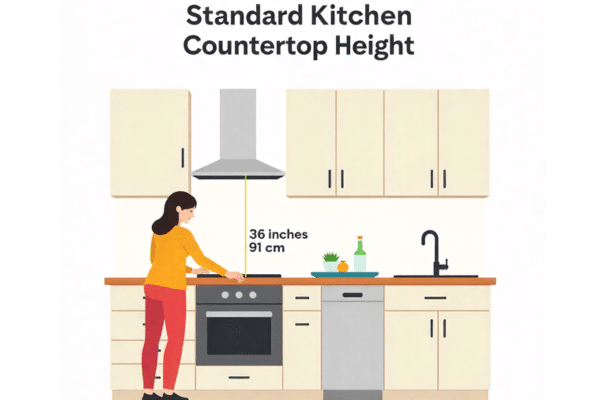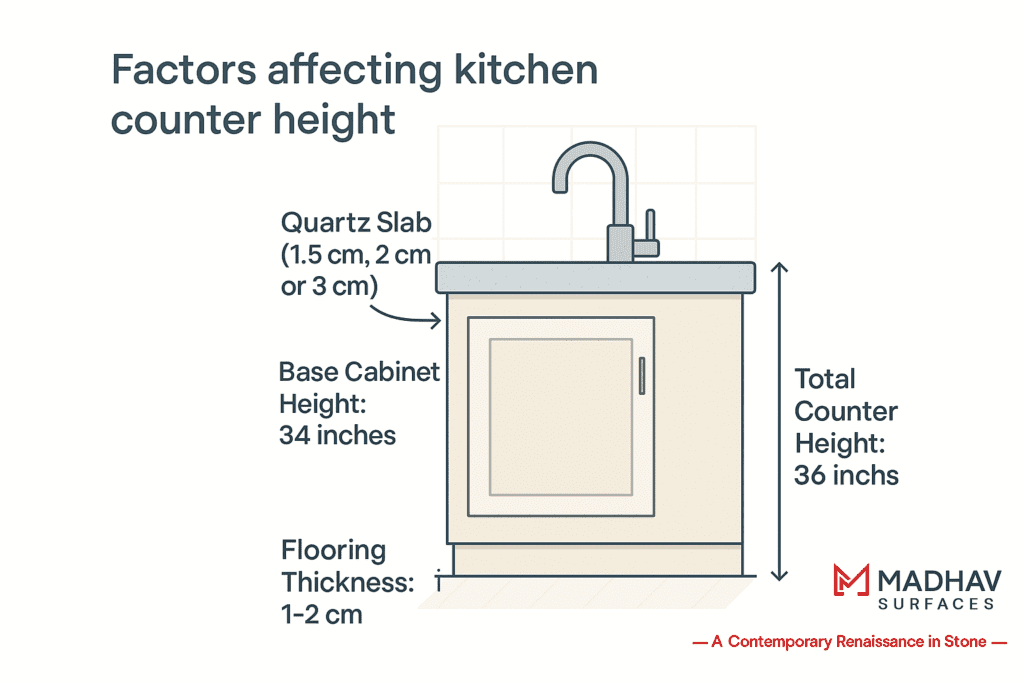What is the Standard Height of a Kitchen Countertop?

The kitchen is where style, ease and practicality meet. Even if you are starting fresh with a new home or upgrading your existing space, choosing the right countertop height is a key decision that affects both comfort and usability. The right height ensures ease of movement, better posture, and a smooth experience when preparing meals or entertaining guests.
Despite what many homeowners believe, there is not an easy approach. While there is a general standard, the ideal countertop height can vary depending on the user’s needs, regional preferences, and the type of material used. In this guide, we will break down everything you need to know about kitchen countertop height, from the standard measurement from the floor to how backsplash and cabinet sizing come into play. We will also explore why the choice of material, especially quartz, matters and where to source premium surfaces from the best quartz manufacturer: Madhav Surfaces.
Let’s Build Stunning Spaces with Quartz
Join hands with Madhav Quartz and get expert support, a wide range of quartz options, and reliable service for your next big project.
Connect NowWhat is the Standard Kitchen Countertop Height?
Most kitchen countertops are typically set at a height of about 36 inches, or roughly 3 feet from the floor. This measurement has been used in both residential and commercial kitchen designs. It balances well with the average adult height, allowing most people to cook comfortably.
But it is not a strict rule. Some kitchens adjust this height based on the
Common Differences
- For taller individuals: 37–38 inches feels more natural
- For shorter users or wheelchair accessibility: 32–34 inches is more comfortable
- Kitchen islands: 42 inches
Why Does the Right Height Matter?
You might not notice the height of your countertop right now, but over time, even a small difference can lead to discomfort. Reaching too high or bending too low multiple times a day adds stress to your back, neck, and shoulders. A measured kitchen countertop height from the floor can improve your posture and make your kitchen more enjoyable to use.
Your countertops should align with cabinetry and appliances to maintain a clean design.
The Role of Backsplash in Countertop Height Planning
While the height of the countertop itself is essential, the kitchen countertop backsplash height plays an equally important role in both design and functionality. A backsplash acts as a barrier, shielding your kitchen walls from moisture, grease, food stains, and heat damage.
Standard Backsplash Height
Typically, a backsplash measures around 4 inches from the countertop surface. This has long been considered the standard, especially in traditional kitchens. However, more recent trends have shifted toward full-height backsplashes, extending all the up to the bottom of the upper cabinets, which is often around 18 inches from the countertop.
Your choice of backsplash height will affect how your countertop, cabinetry, and overall kitchen design come together. A taller backsplash provides more protection and makes a bold visual statement. A 4-inch backsplash, on the other hand, keeps things minimal and may suit smaller or more traditional kitchens.
When pairing a backsplash with quartz countertops, the clean, seamless appearance of full-height quartz backsplashes has become especially popular among homeowners who want an upscale look without too many different textures in the space. You can go for white quartz for a cleaner look.
How Cabinet Size Influences Countertop Height
Cabinet dimensions are closely linked to countertop height. In fact, the kitchen cabinet size in feet is one of the main factors that determines how tall your countertop ends up being.
Standard Cabinet Sizes:
- Base cabinet height (without countertop): Usually around 34.5 inches
- Add the countertop (about 1.5 inches thick) to reach the usual 36-inch height.
If your base cabinets are customized, say, taller or shorter than the average size, your countertop height will naturally adjust to match. That is why it is best to finish your cabinet setup before choosing or placing the countertop.
If you’re working with a modular kitchen setup, some manufacturers offer cabinets in specific height modules (e.g., 2.5 ft or 3 ft), which may vary slightly based on regional standards and the design approach.

Why Is Choosing the Right Material Important?
Beyond size, the type of material you choose also impacts the design and comfort of your kitchen. Quartz, in particular, offers unique advantages when it comes to both aesthetics and durability.
Here’s why more designers and homeowners are choosing quartz countertops from Madhav Surfaces, which is one of the best quartz manufacturers:
- Consistent thickness: Easier to plan and install around cabinets
- Seamless integration with backsplashes
- Non-porous surface: Hygienic and easy to clean
- Wide variety of colors and finishes to suit any design style
With quartz, you also have more flexibility when adjusting height without compromising on strength or visual appeal. Even if you are designing a family kitchen or a compact studio, quartz gives you both structure and style. You can consider Bianco Tiffone to give a subtle look to your kitchen.
Kitchen Islands and Height Differences
While the standard kitchen countertop height from the floor is typically around 36 inches, things can shift when it comes to kitchen islands. These multi-use surfaces are often customized based on what they’ll be used for most, cooking, prep work, dining, or even working from home.
Common Kitchen Island Heights:
- Standard island (prep-focused): ~36 inches (same as base countertop height)
- Bar-height island: ~42 inches
- Table-height island: ~30 inches
A prep-focused island usually matches the rest of the kitchen for visual harmony. But if the island includes a dining area or bar seating, raising part of it creates a clear functional divide. This dual-level layout also allows different users, like children and adults, to use the kitchen comfortably at the same time.
Choosing quartz for your island surface ensures that even with height variations, the overall look remains seamless. Madhav Surfaces offers quartz slabs in various thickness options, making it easier to achieve the right balance of height and strength.
International Variations in Countertop Height
Interestingly, the standard kitchen countertop height is not exactly the same across the world. While 36 inches (91.5 cm) is common in North America and India, preferences do vary slightly by region:
- Europe: Often uses 34 to 35.5 inches (~86–90 cm)
- Japan: Tends toward lower counters around 33 inches (~84 cm), especially in older homes
- Scandinavian kitchens: Sometimes opt for taller counters, around 37–38 inches, to suit the taller average height
Understanding these variations is useful, especially if you’re designing a kitchen inspired by international styles or sourcing materials globally. Thankfully, quartz surfaces are easy to cut and customize, making them ideal no matter where your design inspiration comes from.
Countertops for Special Needs and Accessibility
Not all kitchens are built for the average user, and they should not be. Designing with accessibility in mind is important for making a home usable and comfortable for everyone.
Adjusted Heights for Accessibility:
- Wheelchair users: Countertops are typically lowered to around 32–34 inches
- Multi-user households: May benefit from tiered surfaces, some higher, some lower
- Aging-in-place designs: Focus on ease of reach, including both lower counters and shallow-depth cabinets
Quartz surfaces offer the flexibility and durability needed for these setups. They hold up well over time, resist damage, and maintain their finish even with daily use. Our quartz slabs are especially suited for these adaptive layouts due to their strength, uniform thickness, and easy maintenance.
How to Choose the Right Countertop Height for Your Kitchen?
When designing or remodeling a kitchen, one of the most important decisions is the height of the countertop.
While the standard kitchen countertop height from the floor is approximately 36 inches (91.5 cm), that measurement will not always work for every household. Personal comfort, kitchen function, and design details should play a more important role in the decision.
Think about who will be using the kitchen the most: is it a tall person, someone of average height, or several people who will share the space? A countertop that is too high can lead to shoulder and neck strain during long food prep, while a lower surface may cause a person to develop back issues.
One practical way to know comfort height is by doing tasks like chopping vegetables or stirring and then measuring from the elbow to the desired surface. This can help you know what is most suitable.
It is also a smart move to test a few heights physically using cardboard stacks, boxes, or wooden planks before making permanent changes. Set up a counter and perform your typical kitchen tasks; it may give preferences that don’t go well with the standard height.
Another factor to consider is how the space will be used. For example, baking lovers prefer a lower surface (around 30 inches), while a breakfast bar or high seating area might require counters at 40 to 42 inches for comfort. It is totally fine, and often ideal, to have spaces in the kitchen designed at different heights depending on their function.
Factors That Can Alter Final Counter Height
Flooring is another detail that can impact your measurements. If you have not installed your tiles or hardwood yet, remember that floor thickness will raise the final counter height. A shift of even one or two centimeters can make a noticeable difference in comfort, especially if you are particular about posture.
On top of that, the thickness of the countertop material plays an important role. At Madhav Surfaces, quartz slabs typically come in 1.5 cm, 2 cm, or 3 cm options. This added thickness directly affects your overall counter height, and it should be factored into your plan.
Installing a thick countertop on already tall cabinets might push the surface beyond comfortable use. So, when you are designing the layout, remember to add the slab thickness to your base cabinet height.
Choosing the right kitchen countertop height is about more than just looks, it’s a mix of comfort, function, and smart planning. While the 36-inch standard works for many, your best option may vary slightly depending on your needs and setup. Working with experienced professionals like Madhav Surfaces ensures that the height you choose works for both your body and your lifestyle. The goal is to create a kitchen that looks and feels great to use every single day.

Why Choose Madhav Surfaces for Your Quartz Countertops?
When it comes to building a kitchen that’s both functional and visually striking, material selection matters. That’s why so many homeowners and designers turn to Madhav Surfaces, a trusted name in premium quartz manufacturing.
Here’s what sets us apart:
- Unmatched Quality: Every quartz slab is crafted with precision and consistency, ensuring your kitchen surface looks great and performs even better.
- Design Variety: Whether you prefer classic whites, bold veining, or soft neutral tones, their wide selection has something to match every style.
- Durability That Lasts: Our quartz is known for its strength, stain resistance, and low maintenance, perfect for busy kitchens.
- Customization Support: From full-height backsplashes to customized island dimensions, our team can help you match product specifications with your layout needs.
- Sustainability Practices: Responsible sourcing and eco-friendly production methods make us a top choice for conscious consumers.
Conclusion
The right kitchen countertop height is about more than following standards; it’s about comfort, design balance, and how your space feels day to day. Even if you are building a new kitchen or updating an old one, paying attention to the details like cabinet sizing, backsplash height, and how it all ties together with your materials makes a big difference.
And if you’re working with quartz, getting your dimensions right is even easier, especially when you work with experienced suppliers like Madhav Surfaces.
With our wide range of durable, beautiful quartz slabs, you will have all the options you need to build a kitchen that works for you in every way. Contact us for more information.

